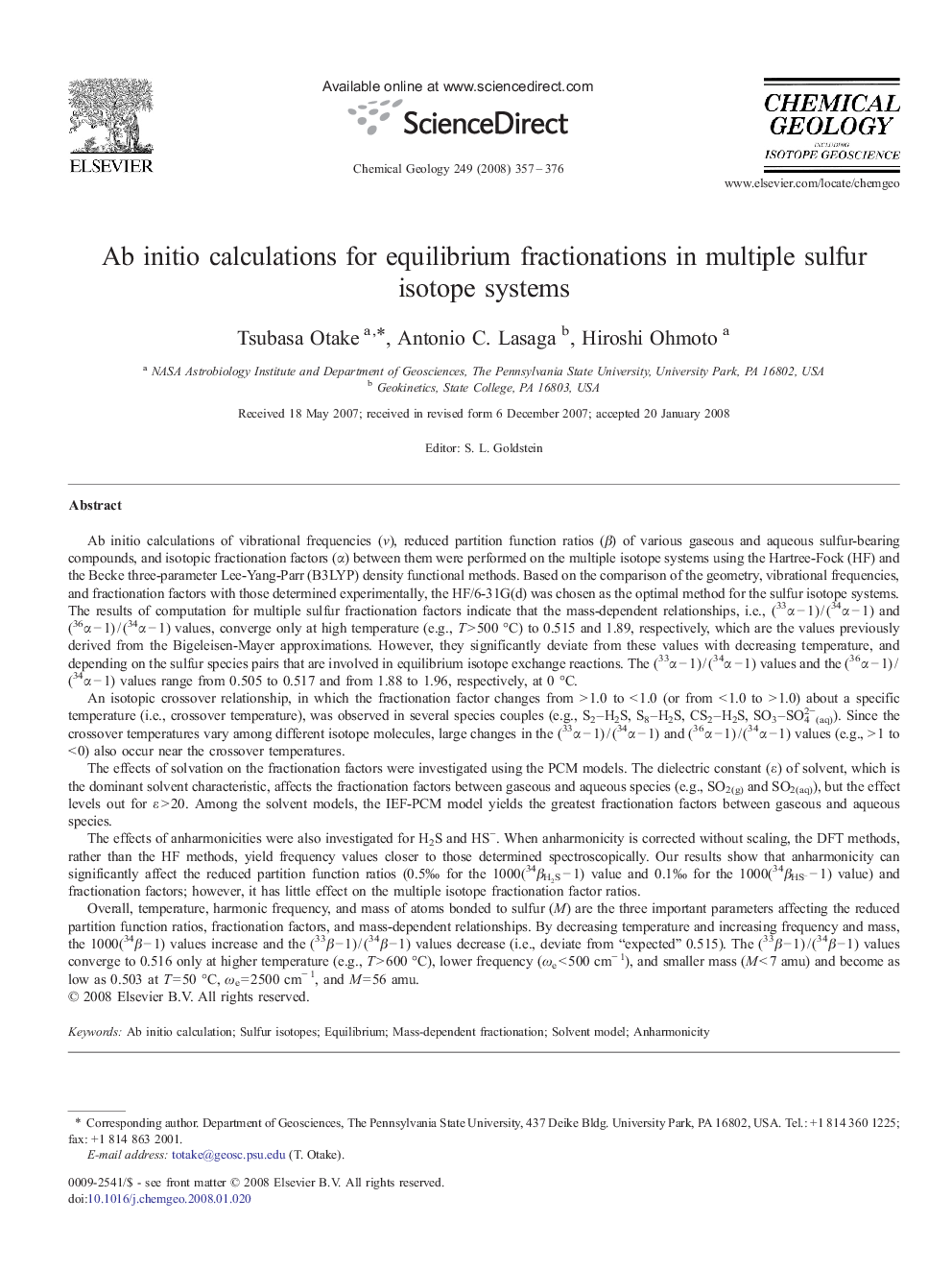| Article ID | Journal | Published Year | Pages | File Type |
|---|---|---|---|---|
| 4700774 | Chemical Geology | 2008 | 20 Pages |
Ab initio calculations of vibrational frequencies (ν), reduced partition function ratios (β) of various gaseous and aqueous sulfur-bearing compounds, and isotopic fractionation factors (α) between them were performed on the multiple isotope systems using the Hartree-Fock (HF) and the Becke three-parameter Lee-Yang-Parr (B3LYP) density functional methods. Based on the comparison of the geometry, vibrational frequencies, and fractionation factors with those determined experimentally, the HF/6-31G(d) was chosen as the optimal method for the sulfur isotope systems. The results of computation for multiple sulfur fractionation factors indicate that the mass-dependent relationships, i.e., (33α − 1) / (34α − 1) and (36α − 1) / (34α − 1) values, converge only at high temperature (e.g., T > 500 °C) to 0.515 and 1.89, respectively, which are the values previously derived from the Bigeleisen-Mayer approximations. However, they significantly deviate from these values with decreasing temperature, and depending on the sulfur species pairs that are involved in equilibrium isotope exchange reactions. The (33α − 1) / (34α − 1) values and the (36α − 1) / (34α − 1) values range from 0.505 to 0.517 and from 1.88 to 1.96, respectively, at 0 °C.An isotopic crossover relationship, in which the fractionation factor changes from > 1.0 to < 1.0 (or from < 1.0 to > 1.0) about a specific temperature (i.e., crossover temperature), was observed in several species couples (e.g., S2–H2S, S8–H2S, CS2–H2S, SO3–SO42−(aq)). Since the crossover temperatures vary among different isotope molecules, large changes in the (33α − 1) / (34α − 1) and (36α − 1) / (34α − 1) values (e.g., > 1 to < 0) also occur near the crossover temperatures.The effects of solvation on the fractionation factors were investigated using the PCM models. The dielectric constant (ε) of solvent, which is the dominant solvent characteristic, affects the fractionation factors between gaseous and aqueous species (e.g., SO2(g) and SO2(aq)), but the effect levels out for ε > 20. Among the solvent models, the IEF-PCM model yields the greatest fractionation factors between gaseous and aqueous species.The effects of anharmonicities were also investigated for H2S and HS−. When anharmonicity is corrected without scaling, the DFT methods, rather than the HF methods, yield frequency values closer to those determined spectroscopically. Our results show that anharmonicity can significantly affect the reduced partition function ratios (0.5‰ for the 1000(34βH2S − 1) value and 0.1‰ for the 1000(34βHS− − 1) value) and fractionation factors; however, it has little effect on the multiple isotope fractionation factor ratios.Overall, temperature, harmonic frequency, and mass of atoms bonded to sulfur (M) are the three important parameters affecting the reduced partition function ratios, fractionation factors, and mass-dependent relationships. By decreasing temperature and increasing frequency and mass, the 1000(34β − 1) values increase and the (33β − 1) / (34β − 1) values decrease (i.e., deviate from “expected” 0.515). The (33β − 1) / (34β − 1) values converge to 0.516 only at higher temperature (e.g., T > 600 °C), lower frequency (ωe < 500 cm− 1), and smaller mass (M < 7 amu) and become as low as 0.503 at T = 50 °C, ωe = 2500 cm− 1, and M = 56 amu.
